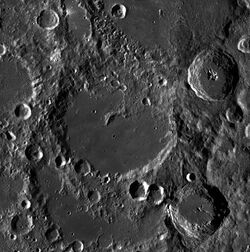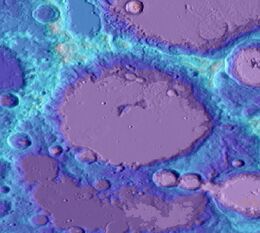Astronomy:Von Kármán (lunar crater)
 LRO image | |
| Diameter | 186.35 km |
|---|---|
| Depth | 13 km |
| Colongitude | 188° at sunrise |

Von Kármán is a large lunar impact crater that is located in the southern hemisphere on the far side of the Moon. The crater is about 186 km (116 mi) in diameter and lies within an immense impact crater known as the South Pole–Aitken basin of roughly 2,500 km (1,600 mi) in diameter and 13 km (8.1 mi) deep.[1] Von Kármán is the site of the first soft-landing on the lunar far side by the Chinese Chang'e 4 spacecraft on 3 January 2019.
Name
The crater is named after Hungarian-American aeronautical engineer Theodore von Kármán.
Overview
The northern third of this formation is overlain by the rim and outer rampart of the walled plain Leibnitz, forming a deep indentation in the formation. The remainder of the outer wall is roughly circular in shape, although it is irregular and heavily worn by subsequent impacts.
The interior of Von Kármán has been subjected to flooding by lava flows after the original crater formed, leaving the southern portion of the floor nearly flat. This surface has a lower albedo than the surrounding terrain, and is nearly as dark as the interior of Leibnitz. There is a central peak at the location where the midpoint of the original Von Kármán was formed, which joins with the rougher surface in the northern part of the crater.
In addition to Leibnitz to the north, the crater Oresme is located to the west-northwest, and Finsen lies to the northeast on the edge of Leibnitz's rim. Nearly attached to the southeast rim is the unusual figure-eight-shaped formation Von Kármán L. Directly to the east of this is the crater Alder.
Prior to formal naming in 1970 by the IAU,[2] the crater was known as Crater 434.[3]
Exploration and cotton seeds sprouting
On 3 January 2019, the Chinese spacecraft Chang'e 4 landed inside the crater Von Kármán, becoming the first spacecraft to soft-land on the far side of the Moon.[4] The site has symbolic as well as scientific value. Theodore von Kármán (1881–1963) was the PhD advisor of Qian Xuesen, the founder of the Chinese space program.[5]
Chang'e 4 took cotton seeds on its mission, and on 15 January 2019, China announced that cotton seeds had sprouted, the first "truly otherworldly plant in history".[6]
On 4 February 2019 the IAU approved the name of the landing site as Statio Tianhe.[7] The central peak of Von Kármán, to the northwest of the landing site, was named Mons Tai.[8] Three small craters were also named: Hegu[9] is south of the landing site, Zhinyu[10] is to the west, and Tianjin[11] is to the northeast.
Satellite craters
By convention these features are identified on lunar maps by placing the letter on the side of the crater midpoint that is closest to Von Kármán.
| Von Kármán | Latitude | Longitude | Diameter |
|---|---|---|---|
| L | 47.7° S | 177.9° E | 29 km |
| M | 47.2° S | 176.2° E | 225 km |
| R | 45.8° S | 170.8° E | 28 km |
References
- ↑ Petro, Noah E.; Pieters, Carle M. (2004-05-05), "Surviving the heavy bombardment: Ancient material at the surface of South Pole-Aitken Basin", Journal of Geophysical Research 109 (E6): E06004, doi:10.1029/2003je002182, Bibcode: 2004JGRE..109.6004P
- ↑ Von Kármán, Gazetteer of Planetary Nomenclature, International Astronomical Union (IAU) Working Group for Planetary System Nomenclature (WGPSN)
- ↑ Lunar Farside Chart (LFC-1A)
- ↑ Lyons, Kate. "Chang'e 4 landing: China probe makes historic touchdown on far side of the moon" (in en). The Guardian. https://www.theguardian.com/science/2019/jan/03/china-probe-change-4-land-far-side-moon-basin-crater.
- ↑ "Hsue-Shen Tsien". https://www.genealogy.math.ndsu.nodak.edu/id.php?id=114672.
- ↑ Bartels, Meghan; January 15, Space com Senior Writer |; ET, 2019 11:47am (15 January 2019). "Cotton Seed Sprouts on the Moon's Far Side in Historic First by China's Chang'e 4". https://www.space.com/43012-china-cotton-seed-moon-far-side-chang-e4.html.
- ↑ Statio Tianhe, Gazetteer of Planetary Nomenclature, International Astronomical Union (IAU), Working Group for Planetary System Nomenclature (WGPSN)
- ↑ Mons Tai, Gazetteer of Planetary Nomenclature, International Astronomical Union (IAU), Working Group for Planetary System Nomenclature (WGPSN)
- ↑ Hegu, Gazetteer of Planetary Nomenclature, International Astronomical Union (IAU), Working Group for Planetary System Nomenclature (WGPSN)
- ↑ Zhinyu, Gazetteer of Planetary Nomenclature, International Astronomical Union (IAU), Working Group for Planetary System Nomenclature (WGPSN)
- ↑ Tianjin, Gazetteer of Planetary Nomenclature, International Astronomical Union (IAU), Working Group for Planetary System Nomenclature (WGPSN)
Bibliography
- Andersson, L. E.; Whitaker, E. A. (1982). NASA Catalogue of Lunar Nomenclature. NASA RP-1097.
- Blue, Jennifer (July 25, 2007). "Gazetteer of Planetary Nomenclature". USGS. http://planetarynames.wr.usgs.gov/.
- Bussey, B.; Spudis, P. (2004). The Clementine Atlas of the Moon. New York: Cambridge University Press. ISBN 978-0-521-81528-4.
- Cocks, Elijah E.; Cocks, Josiah C. (1995). Who's Who on the Moon: A Biographical Dictionary of Lunar Nomenclature. Tudor Publishers. ISBN 978-0-936389-27-1. https://archive.org/details/isbn_9780936389271.
- McDowell, Jonathan (July 15, 2007). "Lunar Nomenclature". Jonathan's Space Report. http://host.planet4589.org/astro/lunar/.
- Menzel, D. H.; Minnaert, M.; Levin, B.; Dollfus, A.; Bell, B. (1971). "Report on Lunar Nomenclature by the Working Group of Commission 17 of the IAU". Space Science Reviews 12 (2): 136–186. doi:10.1007/BF00171763. Bibcode: 1971SSRv...12..136M.
- Moore, Patrick (2001). On the Moon. Sterling Publishing Co. ISBN 978-0-304-35469-6. https://archive.org/details/patrickmooreonmo00patr.
- Price, Fred W. (1988). The Moon Observer's Handbook. Cambridge University Press. ISBN 978-0-521-33500-3.
- Rükl, Antonín (1990). Atlas of the Moon. Kalmbach Books. ISBN 978-0-913135-17-4.
- Webb, Rev. T. W. (1962). Celestial Objects for Common Telescopes (6th revised ed.). Dover. ISBN 978-0-486-20917-3. https://archive.org/details/celestialobjects00webb.
- Whitaker, Ewen A. (1999). Mapping and Naming the Moon. Cambridge University Press. ISBN 978-0-521-62248-6.
- Wlasuk, Peter T. (2000). Observing the Moon. Springer. ISBN 978-1-85233-193-1.
 |


